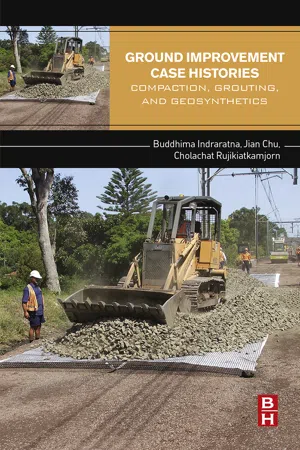1.1 Introduction
Frequent occurrence of devastating seismic events around the world has resulted in a remarkable increase in the public interest toward earthquake preparedness. The known potential for disruption to structures and facilities has encouraged the owners to protect their assets from earthquake hazards. The seismic evaluation/upgrading programs undertaken over the last 20 years by lifeline owners in North America and Japan serves testimony to the significance of this subject (TCLEE, 1998; Wijewickreme et al., 2005). Experience from past seismic events indicates that earthquake-induced permanent ground displacements and/or loss of bearing capacity are some key geotechnical hazards to structures located at sites underlain by liquefiable soils (O’Rourke and Hamada, 1992; MCEER, 1999). After identification of the geotechnical hazards and the resulting vulnerability of a given structure, a combination of structural retrofitting and/or geotechnical remediation (ground improvement) is often considered in the design of mitigative measures.
Historically, ground improvement has been used as a means of improving the postconstruction bearing capacity and settlement performance of soils under static loading conditions, and a variety of ground improvement techniques have evolved in the past few decades (Mitchell, 1981; Japanese Geological Society, 1998). In addition to resisting static loads, some of the ground improvement measures have been effectively used to retrofit facilities that are located within, or that have foundations supported on, liquefiable soils. These measures include dynamic deep compaction, vibro-replacement using stone columns, compaction piling, explosive compaction, and compaction grouting.
The observed performance of sites following major earthquake events—for example, 1964 Niigata (Niigata, Japan), 1995 Hyogoken Nanbu (Kobe, Japan), 1999 Kocaeli (Turkey), 2001 Nisqually (Washington state, U.S.)—indicates that the sites with improved ground had generally less susceptibility to earthquake-induced ground deformations and resulting damage than the sites that had not been densified (Mitchell et al., 1998; Hausler and Sitar, 2001; Hausler and Koelling, 2004).
Amid these ground improvement efforts, including the examination of past earthquake damage and postearthquake operations, there is a need for more documentation of approaches and illustrative case histories related to the use of ground improvement. Clearly, advances in the state of practice in seismic evaluation and retrofit of facilities require dissemination, particularly within the structural and geotechnical engineering disciplines.
With this background, and drawing from a number of case histories from Greater Vancouver, British Columbia (B.C.), Canada, this chapter illustrates several key facets and considerations in the engineering of ground improvement to mitigate liquefaction-induced geotechnical hazards. The sites of the case histories are situated within one of the zones of highest seismic risk in Canada (NBCC, 1995). The region encompasses significant areas underlain by marine, deltaic, and alluvial soil deposits, some of which are considered to be susceptible to liquefaction and large ground movements when subjected to earthquake shaking. Seismic performance of the structures and lifelines located within such weak ground conditions has been of particular concern to the region at large.
The following aspects are specifically addressed:
• Current approaches for the evaluation of seismic vulnerab...
